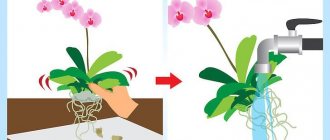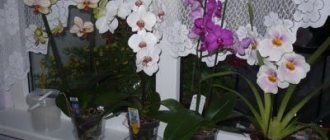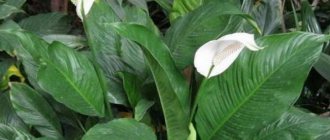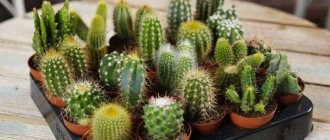Photo of flowers Fuchsia (Fuchsia) is an evergreen shrub that quickly reaches a size of 30 cm to one meter. Larger specimens are also found.
Fuchsia is native to Central and South America, in particular Peru, Chile, Bolivia, Ecuador, and Guatemala.
The leaves are oblong in shape with serrated tips. They are located opposite on the bush. Flowering is abundant, from May to October. Flowers of the most varied colors: white, pale pink, red, bright crimson, lilac. There is a combined color of the petals.
The plant is perennial and requires periodic renewal of the root system. Propagated by seeds, flowers form fruit or by cuttings. Requires sufficient lighting, regular watering and moisturizing to maintain.
| High growth rate. In one season, the plant gains 35-40 cm in height. |
| Blooms from spring to autumn. |
| The plant is easy to grow. |
| Perennial plant with periodic renewal. |
Beneficial features
There are beliefs that fuchsia grown at home helps improve well-being in case of digestive disorders, diseases of the thyroid gland and endocrine system. It awakens creativity in household members and improves well-being. Promotes the development of intuition. Parents find a common language with their children faster, and the general background in the house is harmonized.
For practical purposes, it is worth noting the edibility and excellent taste of the fruit. They can be consumed in the form of jam and liqueur. Prepare pies.
Transfer
Fuchsia must be replanted annually in the spring. When replanting, the fuchsia stem is often cut back to the woody point, this will give the flower a more beautiful shape. The soil plays a big role; fuchsia needs fertile soil with drainage. Humus, humus, and sand will also not be superfluous; they will add looseness to the soil, and if the pot is on the balcony, loam will do. Mix soil and additives in equal quantities.
The pot for replanting should be large and ceramic (to eliminate the possibility of overheating of the root system)
Features of growing at home. Briefly
Decorative fuchsia indoors requires careful care. In indoor conditions it is rarely possible to grow a flower more than 30-50 cm in height. The plant is considered especially attractive during the flowering period. Content criteria:
| Temperature | In summer the temperature is considered to be 18-25 degrees, in winter around 5-10 degrees. |
| Air humidity | A high percentage of moisture should be maintained and sprayed daily. |
| Lighting | Loves bright diffused light. Avoid exposing the leaves to direct sunlight, which can cause burns to the plant. |
| Watering | Abundant, from the pallet. In winter, reduce and avoid wetting the foliage. |
| Priming | Slightly acidic soil with good drainage is suitable. |
| Feeding and fertilizer | During the flowering period (spring-autumn), fertilize with mineral fertilizers every 2 weeks. Do not fertilize the soil in winter. |
| Transfer | This is done as the roots fill the pot, in early spring. The plant is perennial and requires periodic renewal. |
| Reproduction | Two methods are used - seeds and cuttings. |
| Features of cultivation | In summer it is necessary to take the pot out into the open air and avoid drafts. In winter, growth slows down, buds are pinched, and watering is reduced. |
Plant varieties
Increased interest in fuchsia is an incentive for breeders, so now you can find different colors of this crop.
There are also species that bloom at different times of the year. The three-leaf plant has the appearance of a long bell of bright red color. This is a low shrub that grows faster in width. Blooms from May to mid-autumn. In summer it can withstand direct sunlight.
Magellan is a two-color species - a combination of purple and red shades in peduncles. The shrub can reach 3 meters in height, so it is preferable to grow it in greenhouses.
Sparkling fuchsia is a tall two-meter bush. Unopened red buds. When the sepals open, deep purple terry petals appear. Capable of blooming all summer. Looks good in ensembles and flower arrangements.
Alisson Bell is a combination of soft pink sepals and bright pink semi-double petals.
Anabel is a white terry fuchsia. The flowers are large with splashes of pink.
Ballerina - sepals of rich pink, almost cherry color, the skirt is white with a pinkish tint, densely doubled. The flowers are small in size, but the entire bush is dotted with them.
Blue Angel - a combination of white sepals and blue petals of the skirt. Double flowers.
Hollies Beauty has elongated buds that combine white sepals and a skirt with a soft lilac hue.
Archie Owen is a fuchsia with large, densely-double pink flowers. Sepals are wavy.
Bella Rosella is a species that has some of the largest flowers. The color is rich pink. Always blooms profusely and for a long time.
Blue Vale - can be bush or canopy. The skirt is soft lilac, the sepals are white. Sets many buds and blooms from spring to late autumn.
Cecil is a densely double form with pink sepals and lilac, lavender-like wavy petals.
Caring for fuchsia at home. Details
Let's look at the main points.
Landing
When you bring fuchsia home from the store, you should immediately start planting it in a new pot. When landing, we carry out the following procedure:
- choose slightly acidic, loose soil;
- pour one-third of the drainage mixture into the bottom of the pot, then fill it to the middle with soil;
- plant the plant, sprinkle with the remaining soil;
- Pour plenty of water at room temperature. You can fertilize the soil with mineral complexes.
On a note! Fuchsia transplantation is carried out in a similar way.
Bloom
The flowering period begins from May to the end of August. In winter, the plant should be protected from growth, pinched, so that next spring it will again please with lush inflorescences.
The exotic fuchsia flower can take on different colors at home: white, pink, bright red. Wilted flowers should be picked off immediately. A new one will bloom in its place. Pruning the stems should be done extremely carefully during the flowering period so as not to damage the bud buds.
Temperature
The temperature should be kept fairly cool. In summer no higher than 25 degrees, in winter the ideal temperature is up to 15 degrees. In a cool room, fuchsia can take a break from summer flowering.
Spraying
The flower is a tropical resident, so the humidity in the room should be as high as possible. Buy an air humidification system and spray the fuchsia with a spray gun daily. Keep the pot away from radiators and stoves.
Lighting
You should choose a well-lit place for the pot. However, avoid bright sunlight. Protect the flower from drafts and sudden changes in temperature, otherwise the flowers may fall off.
Watering
The water that is used to water the flower must settle. There is a misconception that the flower likes excessive watering. This is wrong. The soil must not be over-moistened. The plant may die due to root rot. It's better to do this:
- give the plant a shower several times a week;
- Spray the flower daily. You can add vitamins and fertilizer to the water.
- water from the pan, drain excess water;
- Watering is best done either early in the morning or after sunset.
Pot size
When choosing a pot, it is worth keeping in mind that fuchsia does not like overly loose or, on the contrary, small pots. The shoot should be planted in a simple glass. As it takes root, transplant it into a small pot. In total, it is recommended to replant fuchsia 4-5 times in the first year. After the first year of life, the flower is usually replanted no more than once a year. It is advisable to plant in a ceramic pot rather than a plastic one.
Priming
In order for home fuchsia to take root and bloom as quickly as possible, the soil must consist of earth, peat and sand. Good drainage is ensured by expanded clay at the bottom of the pot. The soil should be loose; periodically you need to loosen the soil. This will provide oxygen access to the roots.
Feeding and fertilizer
To achieve lush flowering, feed your fuchsia regularly. The most useful fertilizers:
- Nitrogen. Preferred for young plants, as it promotes intensive growth. Gives the leaf a bright green color.
- Potassium and phosphorus. Promotes abundant flower production in the plant. During flowering, it is advisable to spray the buds with a mixture of water and fertilizer.
- Organic and mineral fertilizers. Feed once every few weeks, excluding winter. Promotes strengthening of the root system and high growth rates.
Which fertilizers to choose?
It is not recommended to feed a newly transplanted plant, as well as a sick or weakened one. This could harm him even more.
If the plant is healthy and has already adapted after transplantation, then you can start feeding. Fertilizers differ at different growth stages. Young fuchsia loves nitrogen-containing fertilizers . It is thanks to them that the flower has a rich green color and grows quickly.
For abundant flowering, an adult plant should be fed with fertilizers containing phosphorus and potassium. Before watering, it is best to reduce the concentration of fertilizers by five times from the recommended one. Fuchsia also responds well to organic fertilizers, but it is better to alternate them with mineral ones. The plant should be fertilized every two weeks.
Reproduction
Propagation by cuttings
This type of vegetative propagation of fuchsia is more suitable for beginners. The best time is early spring or late summer.
- The cutting should be harvested from a healthy plant.
- Inspect the fuchsia for yellow leaves, pests in the soil and on the stems. Young stems that have at least several pairs of leaves and a flower bud are suitable.
- Place the shoot, cut at an angle of 45 degrees, in a glass of water and place it in a well-lit place, waiting for the roots to appear.
- Or we immediately plant it in a pot of soil and moisten the soil.
- As it grows, we tear off the leaves on the lower part of the stem. This way, the infection from the ground will not spread to the plant.
Growing fuchsia from seeds
When choosing seeds in a store, pay attention to their expiration date. It should not exceed 3 years. Remember - the fresher the seeds, the better their similarity.
Sown in the ground from late February to April. The ground should be light. It is better to buy a ready-made mixture at a flower shop for these purposes.
Choose a wide pot with low sides for sowing to ensure faster soil warming. Places it in a lighted place. Periodically water and humidify the air. After some time, the seedlings have appeared and become stronger and are transplanted into a pot.
How to plant seedlings in flower pots
It is recommended to plant seedlings in a hanging pot once the root system becomes strong and resistant to external influences. Before planting, it is recommended to moisten the soil generously and replant the flower using the transshipment method. This will protect sensitive roots from injury.
When planting a young sprout of an ampelous variety in a pot, tilt it slightly, placing it closer to the edge of the pot. In the near future, this will make it possible to form a cascading waterfall with bright inflorescences from a lush bush. It is better to choose a clay pot. It will protect the root system of the flower from summer heat and burnout.
By following the rules for growing and caring for young shoots, the owner will receive an amazingly beautiful bush. It will delight you for a long time with its bright buds and lush greenery.
vote
Article Rating
Diseases and pests
- Yellowness has appeared on the leaves - this effect can occur when fuchsia is kept in a too dry room. Remember that in winter, water the plant sparingly. After all, the leaves turn yellow due to waterlogging of the soil. Drying the root system can help eliminate the problem. Place the pot near a heat source for a short time. Next, water from the pan, avoiding excessive moisture of the soil.
- Brown spots on fuchsia leaves - the problem arises due to a violation of the soil irrigation regime with water. Watering may be insufficient, or, conversely, too intense. If the roots of the plant are waterlogged and the total volume of leaves with brown spots exceeds 70%, emergency measures should be taken. Remove the plant from the pot, dry the roots, cut off the rotten ones. Replant into new soil, then fertilize with vitamins and special fertilizers. In the first two weeks, reduce watering.
On a note! The root system can rot when watering from the tray of the pot. Make sure that the water does not remain for long; irrigate the pan if necessary.
- Doesn't bloom well - this problem can be especially frustrating for flower owners. Why does fuchsia not bloom at all or rarely and for a short time? There may be several reasons.
First, the flowering period is affected by the amount of sunlight. If in the summer, during the growth period, they do not have enough light, moreover, if they are not watered enough and fed poorly, the flowering period can be significantly reduced.
Secondly, excessively high indoor temperatures in winter have a bad effect on the duration of flowering. In winter, when daylight hours are short, you should not water the flower abundantly and often. By following simple rules, you can achieve long-term flowering of the plant:
- In winter, water infrequently, place the flower in a bright place, and maintain air humidity of at least 70%. To do this, place the pot away from heating systems.
- In summer, place the fuchsia pot in a well-lit place and water more abundantly. Feed with fertilizers every week.
- Fuchsia leaves are falling. The reason for this phenomenon may be the lack of long daylight hours and lack of watering. Dry air also causes the plant to begin to shed its leaves. All of the above conditions are typical for the winter period. Don't be upset! Provide the flower with additional electric lighting. Maintain air humidity using a sprayer or room humidifier. Feed and water your flower on time, and it will survive the winter safely.
Advice! Avoid winter flowering, which can further weaken your beauty. To do this, you should pinch the emerging buds in time.
- Buds and flowers fall. This problem can occur in a plant for many reasons. Let us consider in detail the sources of occurrence and methods of solving the problem.
- drafts and temperature changes are one of the unfavorable factors that negatively affects the growing conditions of the plant. You should not open the window for ventilation if the pot with the plant is on the windowsill. Choose a place with a stable temperature: away from doors, balconies, and open windows.
- changing the location of the pot. Doesn't like climate change. If you often move a flower pot from place to place, be prepared that sooner or later the buds will begin to fall off. Therefore, during the period of bud formation or flowering of the plant, do not move the pot even for watering.
- violation of the watering regime - very often buds fall off due to excessive watering in winter and lack of moisture in the soil in summer. You should remember that you need to water from a tray. After absorbing moisture, the tray is drained to prevent further rotting of the root system.
- lack of lighting. To avoid shedding leaves and flowers, choose a room with diffused bright lighting for the flower. In summer, you can take the pot of fuchsia to the balcony. In winter, when daylight hours are shortened, install a lamp next to the plant.
- violation of the temperature regime - if the air in the room is too dry or, on the contrary, humid, the plant may have problems with flowering. Therefore, maintain an average temperature (24-26 degrees) in the room where the flower is located. The humidity level is at least 70%; for this, practice spraying daily with a spray gun.
- The leaves lose turgor and droop towards the bottom - this is a characteristic sign of insufficient watering of the plant. In order for the leaves to return to a vertical position, you should place the flower under a cool shower. Leave the pot in a tray of water for several hours. In the future, you should regularly humidify the air in the room where fuchsia grows.
- Fuchsia leaves turn yellow . Wilting leaves and flowers may indicate a possible change in humidity. If the fuchsia flower is not sprayed daily and the pot is placed next to heating sources, this problem will certainly arise sooner or later. Also, the tips of the leaves may turn yellow and dry if the root system is damaged. The culprit may be mechanical damage or pest activity.
Other diseases can be caused not so much by careless care as by the action of pests. The plant can be attacked by:
- scale insects;
- thrips;
- aphid;
- spider mite or whitefly.
What to do in the fall
In the fall, you need to prepare the plant for winter dormancy. To do this, from September you need to gradually reduce watering. By the time frost sets in, fuchsia should be dry. Stop giving fertilizer so that the plant begins to shed all its greenery and flowers. Move the fuchsia to a place where the light is much weaker.
If suddenly the room is too dark, then simply turn on the incandescent lamp for several hours every day. It won't be hard work.
To ensure that the plant is fully prepared for hibernation, move it to the balcony or basement. There, fuchsia should be kept at a temperature of no more than fourteen degrees Celsius.
Types of home fuchsia with photos and names
Fuchsia graceful
Fuchsia graceful is a small shrub up to 1 meter in size. The flowers are drooping, bell-shaped, with a pronounced reddish tint. The calyx of the flower is formed by four concave petals, of a reddish hue. The corolla is much shorter in length than the calyx. The color is usually a bright purple hue.
Fuchsia Magellanica
The shrub reaches a height of five meters. However, as a rule, there are specimens up to 2-3 meters. The Magellan species is native to South America, particularly Argentina and Chile. The leaves are elongated, reaching a length of up to 5 cm. The veins are purple, the tips of the leaves are jagged. The flowers grow solitary, often collected in groups of 4-5, drooping. Oblong in shape, reminiscent of a funnel, with a slight reddish tint. Petals at the base with a slight blue tint.
Fuchsia brilliant
Evergreen shrub, up to 1-2 meters high. Habitat: Mexico. The leaves are large, oblong in shape. They reach a length of up to 20 cm, a width of 10-15 cm. The corolla is an elongated narrow tube up to 10 cm long. Inflorescences are racemose. Blooms profusely from June to August.
Fuchsia boliviana
Branched shrub, evergreen. Homeland - South America. Often found in Ecuador, Guatemala, Bolivia. Maximum height 1-1.2 meters. The ovoid leaves reach 15 cm in length. The flowers are tube-shaped, large, bright red.
Popular varieties
There are many varieties of fuchsia that are very popular. Let's look at the features of some of them.
"Annabelle"
White princess in the kingdom of fuchsias. This beauty amazes beginners in floriculture with its fragile and delicate appearance. The flower has a snow-white skirt with pink stamens. The leaf blades are light green in color, but when ripe they darken noticeably.
The variety is characterized by early flowering and active growth. Often people choose “Anabelle” for cultivation precisely because of these factors.
Delta Sarah
Ampel type variety. It is winter-hardy. It is distinguished by beautiful large flowers that always attract a lot of attention. The plant has a strong structure and active growth. Ideal for growing yourself or selling as a showy perennial.
The flowers of this variety are semi-double, colored white and blue. You can’t just walk past the charming flowers without admiring them.
"Waist"
A very beautiful plant that looks interesting. "Talia" is distinguished by rich orange buds. This variety, like those described above, is famous for its active and lush flowering, which continues throughout the spring and autumn seasons.
Flower growers are attracted to “Talia” for its decorativeness and brightness. Its buds are graceful and variegated. This rich bushy plant can grow up to 50 cm. The leaf blades of the flower are velvety with an interesting reddish tint.
"Bella Rosella"
This fuchsia variety is famous for its versatility. A flower can grow at an amazing speed if it is provided with optimal conditions. The shoots of "Bella Rosella" grow very quickly and are unbreakable.
The flowers of representatives of this variety grow quite large. They are characterized by a rich pink (even purple) color of the skirt. The crown of sepals is always very delicate - white and pink. All of the above details form a very beautiful and lush bush. This attractive and elegant flower can decorate any collection.
"Royal Mosaic"
One of the most popular and widespread varieties. Flower growers are happy to grow “Royal Mosaic”, since this plant is characterized by lush and fragrant double-type flowers. The buds are very original - this applies to both color and shape. The skirt has a blue-violet color, rich in tone. This color is offset by a pink underside. Thanks to this color effect, the plant looks very unusual and beautiful.
"New Millennium"
Another decorative variety that is hard not to fall in love with. "New Millennium" is characterized by a very unusual and vibrant appearance. The plant is bushy and branches quickly and well. Easy to shape.
The flowers of this variety look especially beautiful and impressive with the onset of the flowering period. The plant has thin leaf blades of a light green hue, and large lilac buds look great against their background. When the double flowers bloom, showing everyone an unusual color palette, this plant becomes truly luxurious and vibrant.











